Corrosion Behaviors of Artificial Chloride Patina for Studying Bronze Sculpture Corrosion in Marine Environments
Abstract
:1. Introduction
2. Materials and Methods
2.1. Corrosion Experiment
2.2. Analyses
2.2.1. Surface Condition and Form
2.2.2. Chromaticity and Reflectance
2.2.3. Products by Corrosion
2.2.4. Microstructure and Composition
3. Results
3.1. Microstructure and Material Characteristics of Specimen
3.2. Surface Condition and Form
3.3. Chromaticity and Reflectance
3.4. Analysis of Products by Corrosion
3.5. Microstructures and Compositions of Corrosion Products
4. Discussion
4.1. Color Classification and Corrosion Products of Chloride Patina
4.2. Composition and Corrosion Products of Chloride Patina
4.3. Corrosion Mechanism of Chloride Patina
5. Conclusions
Funding
Institutional Review Board Statement
Informed Consent Statement
Data Availability Statement
Conflicts of Interest
References
- English Heritage. Practical Building Conservation: Metals; Routledge: London, UK, 2012; pp. 254–255. [Google Scholar]
- Crippa, M.; Bongiorno, V.; Piccardo, P.; Carnasciali, M.M. A Characterisation Study on Modern Bronze Sculpture: The Artistic Patinas of Nado Canuti. Stud. Conserv. 2019, 64, 16–23. [Google Scholar] [CrossRef]
- Gianni, L. Corrosion Behavior of Bronze Alloys Exposed to Urban and Marine Environment: An Innovative Approach to Corrosion Process Understanding and to Graphical Results Presentation. Ph.D. Thesis, University of Ghent, Ghent, Belgium, 2011; pp. 7–27. [Google Scholar]
- Catelli, E.; Sciutto, G.; Prati, S.; Jia, Y.; Mazzeo, R. Characterization of outdoor bronze monument patinas: The potentialities of near-infrared spectroscopic analysis. Environ. Sci. Pollut. Res. 2018, 25, 24379–24393. [Google Scholar] [CrossRef] [PubMed]
- Albini, M.; Letardi, P.; Mathys, L.; Brambilla, L.; Schröter, J.; Junier, P.; Joseph, E. Comparison of a bio-based corrosion inhibitor versus benzotriazole on corroded copper surfaces. Corros. Sci. 2018, 143, 84–92. [Google Scholar] [CrossRef]
- Kwon, H. The Corrosion Characteristics and Applicability of Non-Destructive Investigation in the Outdoor Bronze Sculptures. Ph.D. Thesis, Kongju National University, Gongju, Republic of Korea, 2023; pp. 6–43. [Google Scholar]
- Kwon, H.; Lee, G. Collaboration with Stakeholders for Conservation of Contemporary Art. J. Conserv. Sci. 2020, 36, 37–46. [Google Scholar] [CrossRef]
- Scott, D.A. Copper and Bronze in Art: Corrosion, Colorants and Conservation; Getty Publications: Los Angeles, CA, USA, 2002; pp. 43–59, 81–99, 122–167. [Google Scholar]
- Liggins, F.; Vichi, A.; Liu, W.; Hogg, A.; Kogou, S.; Chen, J.; Liang, H. Hyperspectral imaging solutions for the non-invasive detection and automated mapping of copper trihydroxychlorides in ancient bronze. Herit. Sci. 2022, 10, 142. [Google Scholar] [CrossRef]
- Porcu, D.; Innocenti, S.; Galeotti, M.; Striova, J.; Dei, L.; Carretti, E.; Fontan, R. Spectroscopic and morphologic investigation of bronze disease: Performance evaluation of portable devices. Heritage 2022, 5, 3548–3550. [Google Scholar] [CrossRef]
- Papadopoulou, O.; Novakovic, J.; Vassiliou, P.; Filippaki, E.; Bassiakos, Y. Chemical corrosion by chlorides on ancient-like bronzes and treatment by hydrogen glow discharge plasma. Appl. Phys. A 2013, 113, 981–988. [Google Scholar] [CrossRef]
- Liu, W.; Li, M.; Wu, N.; Liu, S.; Chen, J. A new application of fiber optics reflection spectroscopy (FORS): Identification of “bronze disease” induced corrosion products on ancient bronzes. J. Cult. Herit. 2021, 49, 19–27. [Google Scholar] [CrossRef]
- Young, M.L.; Schnepp, S.; Casadio, F.; Lins, A.; Meighan, M.; Lambert, J.B.; Dunand, D.C. Matisse to Picasso: A compositional study of modern bronze sculptures. Anal. Bioanal. Chem. 2009, 395, 171–184. [Google Scholar] [CrossRef] [PubMed]
- Day, J.; Stenger, J.; Eremin, K.; Khandekar, N.; Budny, V. Gaston Lachaise’s bronze sculpture in the Fogg Museum. J. Am. Inst. Conserv. 2010, 49, 1–26. [Google Scholar] [CrossRef]
- Ganio, M.; Leonard, A.; Plisson, J.S.; Walton, M. From Sculptures to Foundries: Elemental Analysis to Determine the Provenance of Modern Bronzes. In Proceedings of the 15ème Journées D’étude de la SFIIC-ICOMOS, Paris, France, 4–5 December 2014; pp. 136–144. [Google Scholar]
- Young, M.L.; Dunand, D.C. Comparing compositions of modern cast bronze sculptures: Optical emission spectroscopy versus X-ray fluorescence spectroscopy. JOM 2015, 67, 1646–1658. [Google Scholar] [CrossRef]
- Randall, M.; Zycherman, L.; Griffith, R. Conservation of Joan Miró’s bronze sculptures at the Museum of Modern Art. In Objects Specialty Group Postprints; The American Institute for Conservation of Historic & Artistic Works: Washington, DC, USA, 2018; pp. 233–255. [Google Scholar]
- Pouyet, E.; Ganio, M.; Motlani, A.; Saboo, A.; Casadio, F.; Walton, M. Casting light on 20th-century Parisian artistic bronze: Insights from compositional studies of sculptures using hand-held X-ray fluorescence spectroscopy. Heritage 2019, 2, 732–748. [Google Scholar] [CrossRef]
- Pixabay. Hand of Correlation. Available online: https://pixabay.com/ko/photos/%EC%86%90-%EC%86%90%EA%B0%80%EB%9D%BD-%EC%A1%B0%EA%B0%81%ED%92%88-%ED%8F%AC%ED%95%AD-7000662/ (accessed on 14 September 2023).
- Pixabay. The Little Mermaid. Available online: https://pixabay.com/ko/photos/%EB%8F%99%EC%83%81-%EC%9D%B8%EC%96%B4%EA%B3%B5%EC%A3%BC-%EC%BD%94%ED%8E%9C%ED%95%98%EA%B2%90-4873099/ (accessed on 14 September 2023).
- Pixabay. Gallos. Available online: https://pixabay.com/ko/photos/%EC%99%95-%EC%95%84%EB%A5%B4%ED%88%AC%EC%8A%A4-%EA%B8%88%EC%86%8D-%EC%A1%B0%EA%B0%81%ED%92%88-1507392/ (accessed on 14 September 2023).
- Kwon, H.; Cho, N. Corrosion behaviors of outdoor bronze sculptures in an urban–industrial environment: Corrosion experiment on artificial sulfide patina. Metals 2023, 13, 1101. [Google Scholar] [CrossRef]
- Yonehara, M.; Matsui, T.; Kihara, K.; Isono, H.; Kijima, A.; Sugibayashi, T. Experimental relationships between surface roughness, glossiness and color of chromatic colored metals. Mater. Trans. 2004, 45, 1027–1032. [Google Scholar] [CrossRef]
- Radivojević, M.; Pendić, J.; Srejić, A.; Korać, M.; Davey, C.; Benzonelli, A.; Martinón-Torres, M.; Jovanović, N.; Kamberović, Ž. Experimental design of the Cu-As-Sn ternary colour diagram. J. Archaeol. Sci. 2018, 90, 106–119. [Google Scholar] [CrossRef]
- Strandberg, H. Reactions of copper patina compounds—Ⅰ. influence of some air pollutants. Atmos. Environ. 1998, 32, 3511–3520. [Google Scholar] [CrossRef]
- Krätschmer, A.; OdenvallWallinder, I.; Leygraf, C. The evolution of outdoor copper patina. Corros. Sci. 2002, 44, 425–450. [Google Scholar] [CrossRef]
- Carlo, G.D.; Giuliani, C.; Riccucci, C.; Pascucci, M.; Messina, E.; Fierro, G.; Lavorgna, M.; Ingo, G.M. Artificial patina formation onto copper-based alloys: Chloride and sulphate induced corrosion processes. Appl. Surf. Sci. 2017, 421, 120–127. [Google Scholar] [CrossRef]
- Strandberg, H. Perspectives on Sculpture Conservation: Modelling Copper and Bronze Corrosion. Ph.D. Thesis, University of Gothenburg, Gothenburg, Sweden, 1997; pp. 7–107. [Google Scholar]
- Kwon, H.H.; Kim, Y.S.; Kim, B.J.; Choi, N.Y.; Park, H.S.; Kim, J.S. A study on conservation and material characteristics of out-door bronze sculpture: Kim Chan Shik’s ‘Feeling’. J. Conserv. Sci. 2017, 33, 155–165. [Google Scholar] [CrossRef]
- Masi, G.; Esvan, J.; Josse, C.; Chiavari, C.; Bernardi, E.; Martini, C.; Bignozzi, M.C.; Gartner, N.; Kosec, T.; Robbiola, L. Characterization of typical patinas simulating bronze corrosion in outdoor conditions. Mater. Chem. Phys. 2017, 200, 308–321. [Google Scholar] [CrossRef]
- Masi, G.; Bernardi, E.; Martini, C.; Vassura, I.; Skrlep, L.; Fabjan, E.S.; Gartner, N.; Kosec, T.; Josse, C.; Esvan, J.; et al. An innovative multi-component fluoropolymer-based coating on outdoor patinated bronze for cultural heritage: Durability and reversibility. J. Cult. Herit. 2020, 45, 122–134. [Google Scholar] [CrossRef]
- Scott, D.A. Metallography and Microstructure of Ancient and Historic Metals; The Getty Conservation Institute: Los Angeles, CA, USA, 1991; pp. 2–10. [Google Scholar]
- Fuente, D.; Simancas, J.; Morcillo, M. Morphological study of 16-year patinas formed on copper in a wide range of atmospheric exposures. Corros. Sci. 2008, 50, 268–285. [Google Scholar] [CrossRef]
- Bureš, R.; Klajmon, M.; Fojt, J.; Rak, P.; Jílková, K.; Stoulil, J. Artificial patination of copper and copper alloys in wet atmosphere with increased content of SO2. Coatings 2019, 9, 837. [Google Scholar] [CrossRef]
- Lopesino, P.; Alcántara, J.; De la Fuente, D.; Chico, B.; Jiménez, J.A.; Morcillo, M. Corrosion of copper in unpolluted chloride-rich atmospheres. Metals 2018, 8, 6–16. [Google Scholar] [CrossRef]
- Odenvall Wallinder, I.; Leygraf, C. Seasonal variations in corrosion rate and runoff rate of copper roofs in an urban and a rural atmospheric environment. Corros. Sci. 2001, 43, 2379–2396. [Google Scholar] [CrossRef]
- Es Sebar, L.; Iannucci, L.; Gori, C.; Re, A.; Parvis, M.; Angelini, E.; Grassini, S. In-situ multi-analytical study of ongoing corrosion processes on bronze artworks exposed outdoors. Acta IMEKO 2021, 10, 241–249. [Google Scholar] [CrossRef]
- Basso, E.; Pozzi, F.; Reiley, M.C. The Samuel F. B. Morse statue in Central Park: Scientific study and laser cleaning of a 19th-century American outdoor bronze monument. Herit. Sci. 2020, 8, 7–12. [Google Scholar] [CrossRef]
- Catelli, E.; Randeberg, L.L.; Strandberg, H.; Alsberg, B.K.; Maris, A.; Vikki, L. Can hyperspectral imaging be used to map corrosion products on outdoor bronze sculptures? J. Spectr. Imaging 2018, 7, a10. [Google Scholar] [CrossRef]
- Chiavari, C.; Bernardi, E.; Martini, C.; Passarini, F.; Ospitali, F.; Robbiola, L. The atmospheric corrosion of quaternary bronzes: The action of stagnant rain water. Corros. Sci. 2010, 52, 3002–3010. [Google Scholar] [CrossRef]
- Fitzgerald, K.P.; Nairn, J.; Atrens, A. The chemistry of copper patination. Corros. Sci. 1998, 40, 2029–2050. [Google Scholar] [CrossRef]
- He, J.; Wang, J. Impacts of initial pH and Cl- concentration on nantokite hydrolysis. J. Chin. Soc. Corros. Prot. 2018, 38, 397–401. [Google Scholar]
- Oudbashi, O. Multianalytical study of corrosion layers in some archaeological copper alloy artefacts. Surf. Interface Anal. 2015, 47, 1138–1146. [Google Scholar] [CrossRef]
- Luo, Y.; Zhang, J.; Tian, H.; Wang, Y.; Cui, H.; Ma, Y.; Cui, Q. Interplay between external high pressure and intrinsic Jahn–Teller effect in the compression behavior of clinoatacamite. Inorg. Chem. 2022, 61, 6869–6880. [Google Scholar] [CrossRef] [PubMed]
- Zhang, X.; Odenvall Wallinder, I.; Leygraf, C. Mechanistic studies of corrosion product flaking on copper and copper-based alloys in marine environments. Corros. Sci. 2014, 85, 15–25. [Google Scholar] [CrossRef]
- Wallinder, I.O.; Zang, X.; Goidanich, S.; Bozec, N.L.; Herting, G.; Leygraf, C. Corrosion and runoff rates of Cu and three Cu-alloys in marine environments with increasing chloride deposition rate. Sci. Total Environ. 2014, 472, 690–692. [Google Scholar]
- Considine, B.; Wolfe, J.; Posner, K.; Bouchard, M. Conserving Outdoor Sculpture: The Getty Conservation Institute; The Getty Conservation Institute: Los Angeles, CA, USA, 2010; pp. 94–95. [Google Scholar]
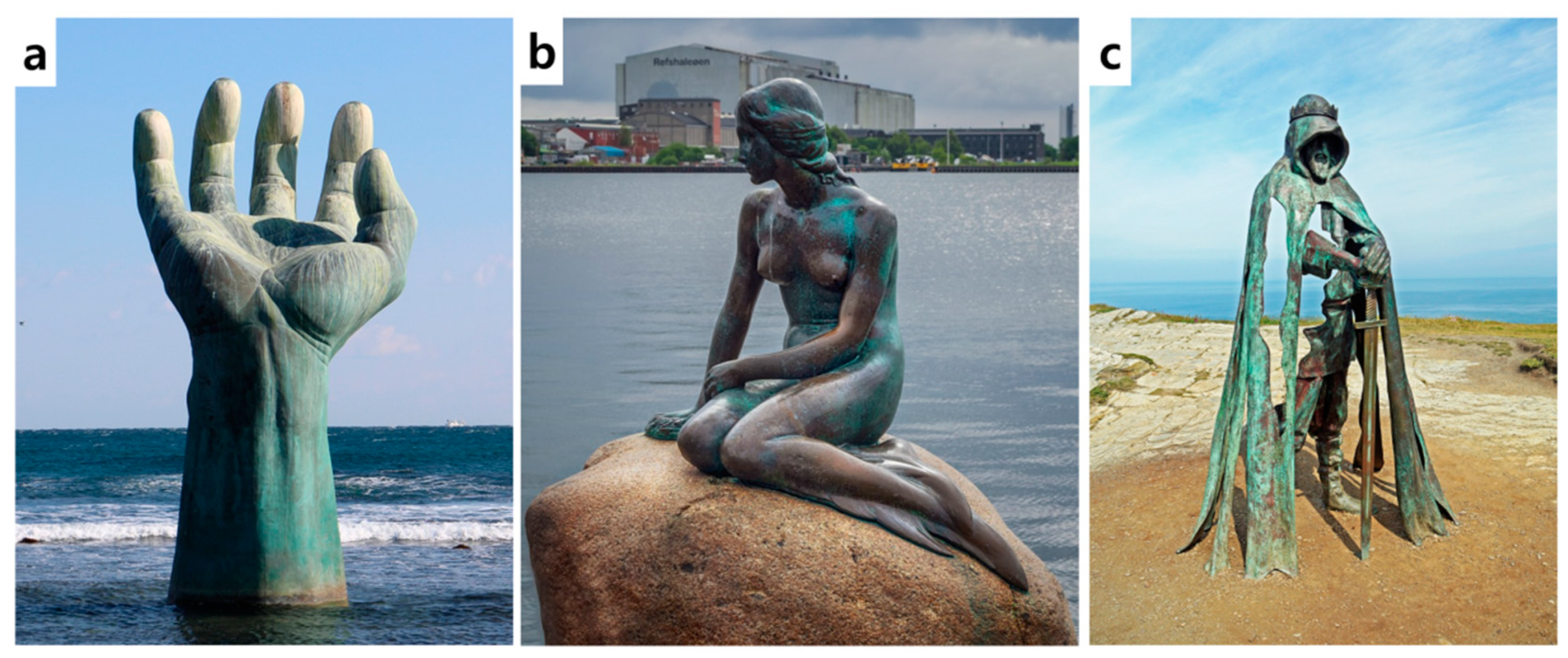
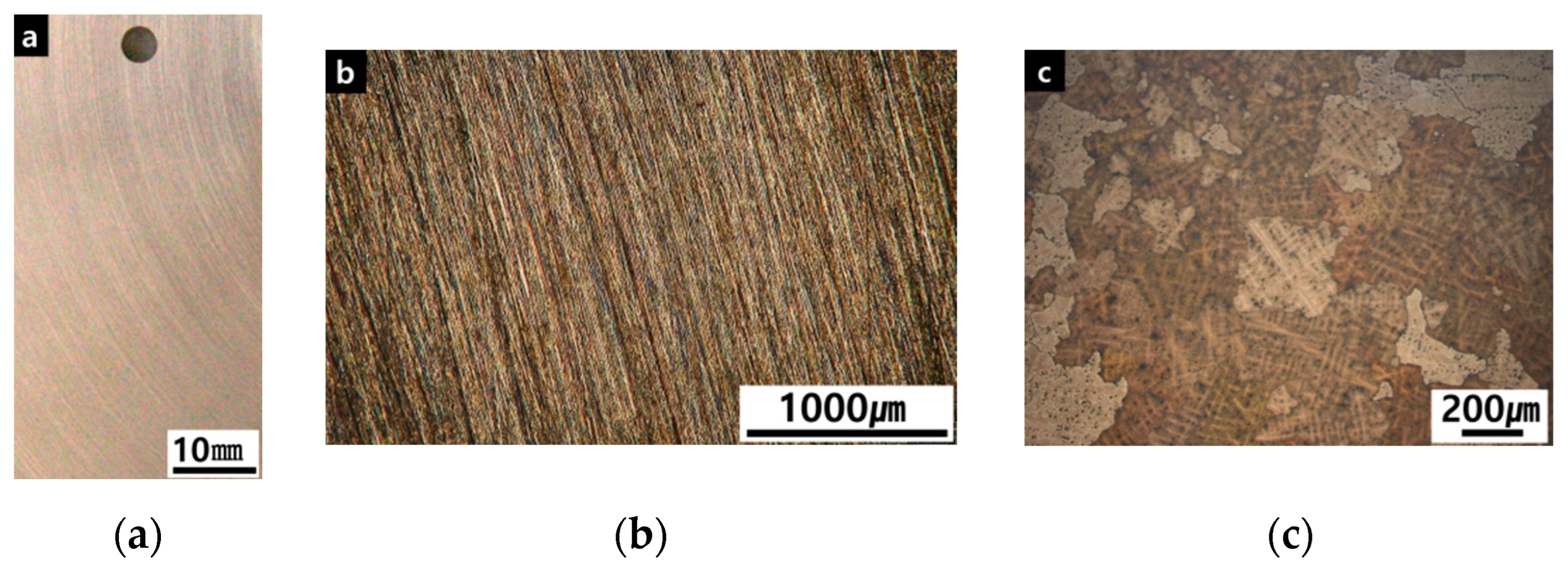


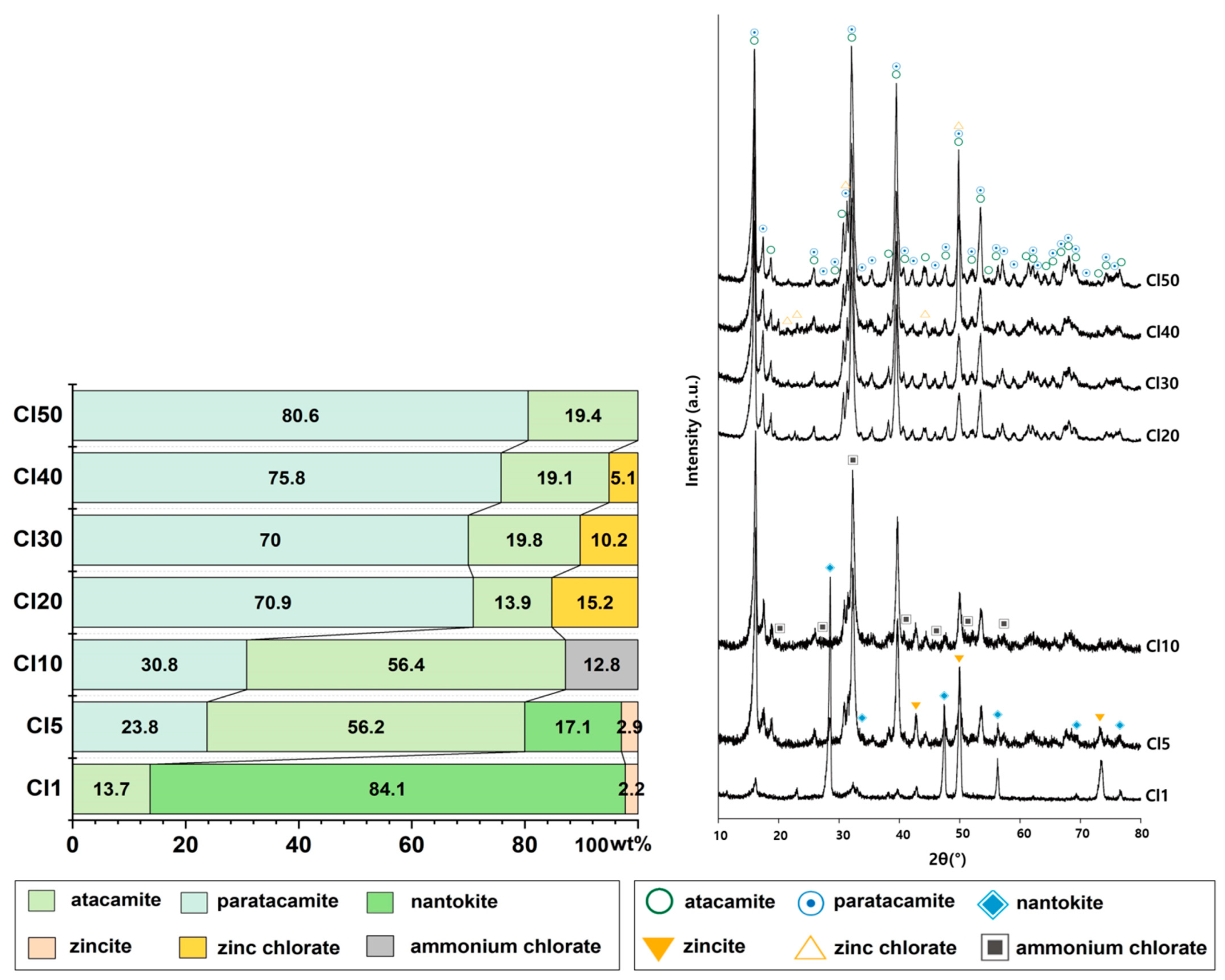


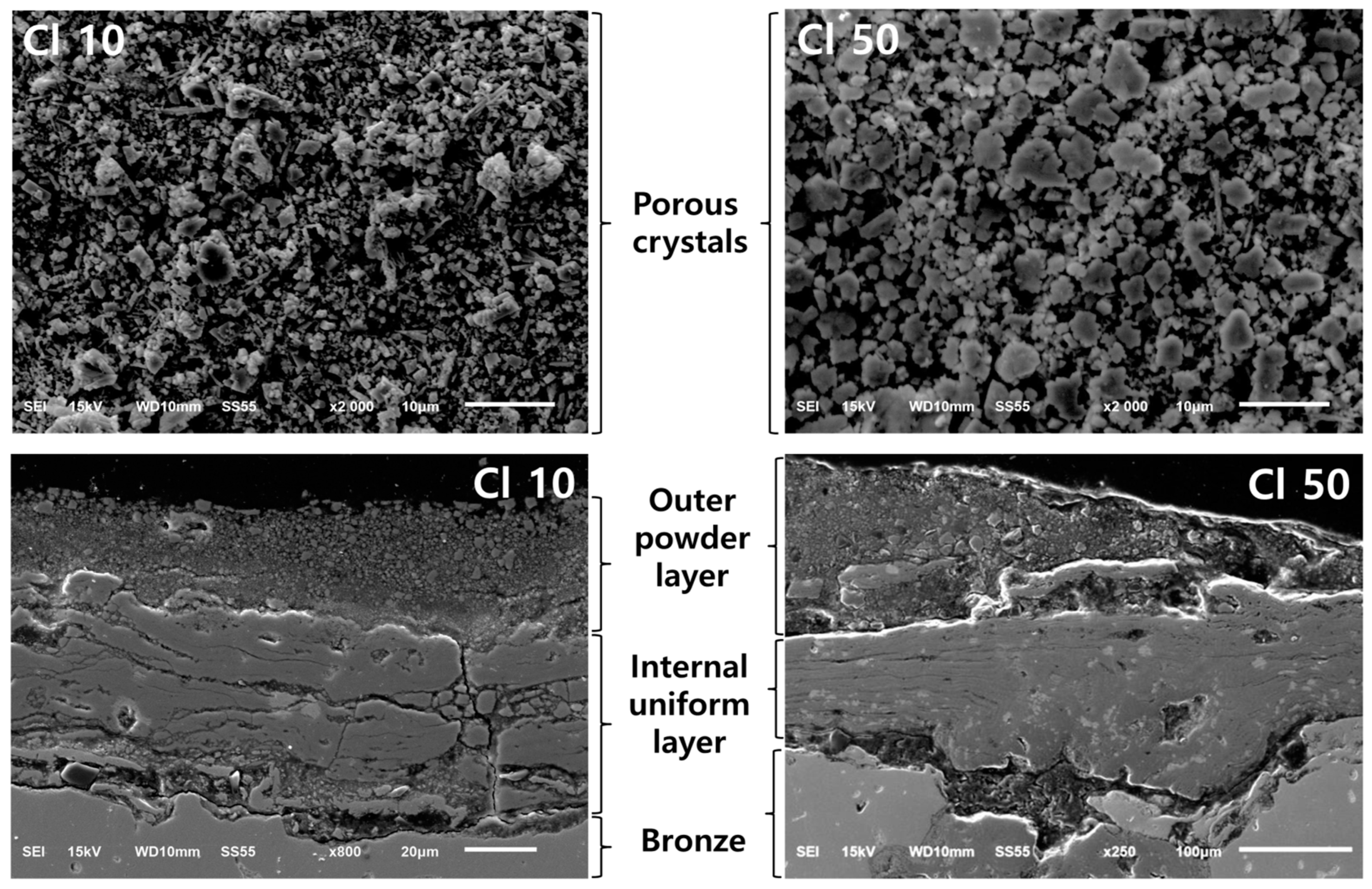
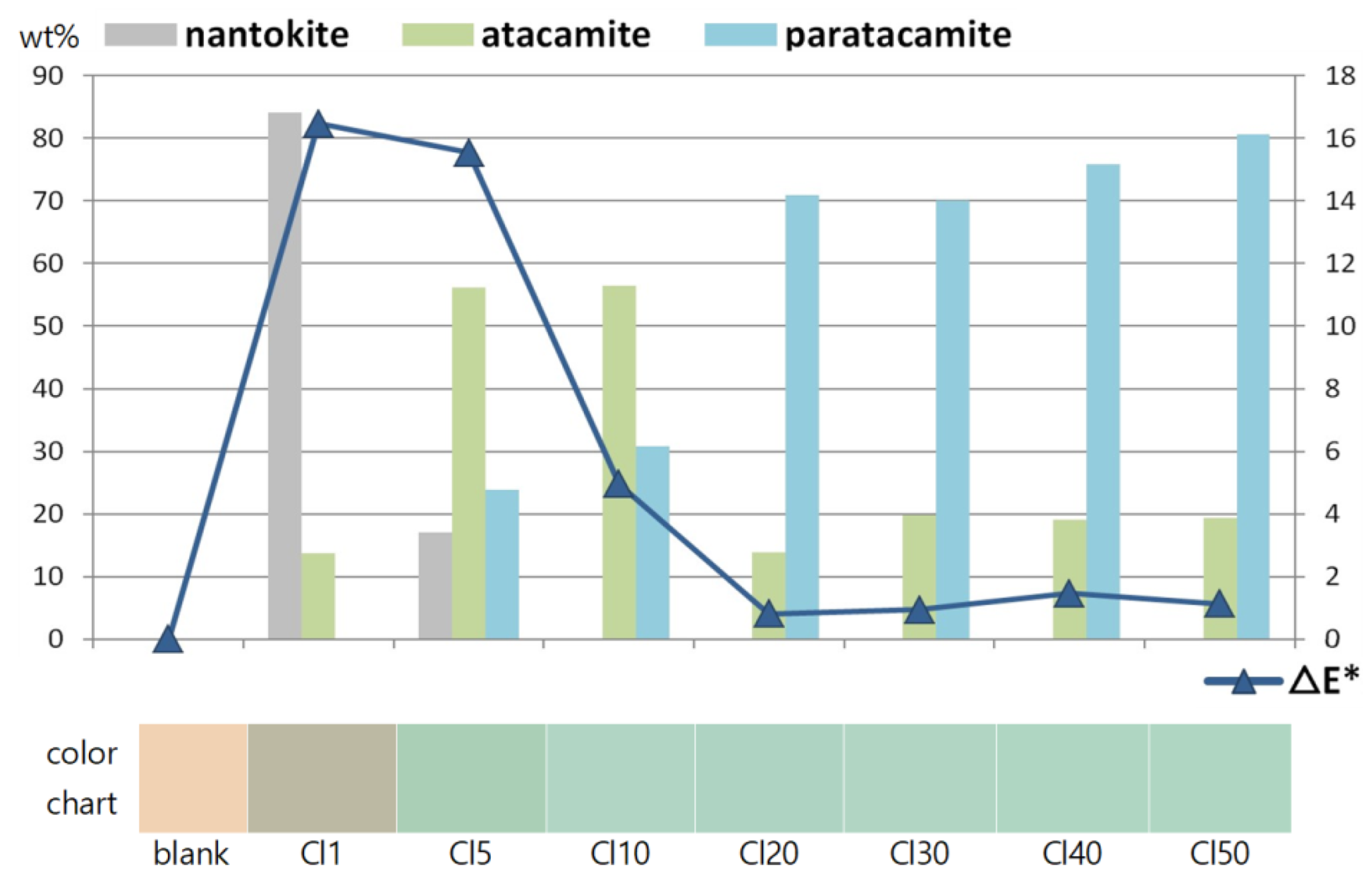

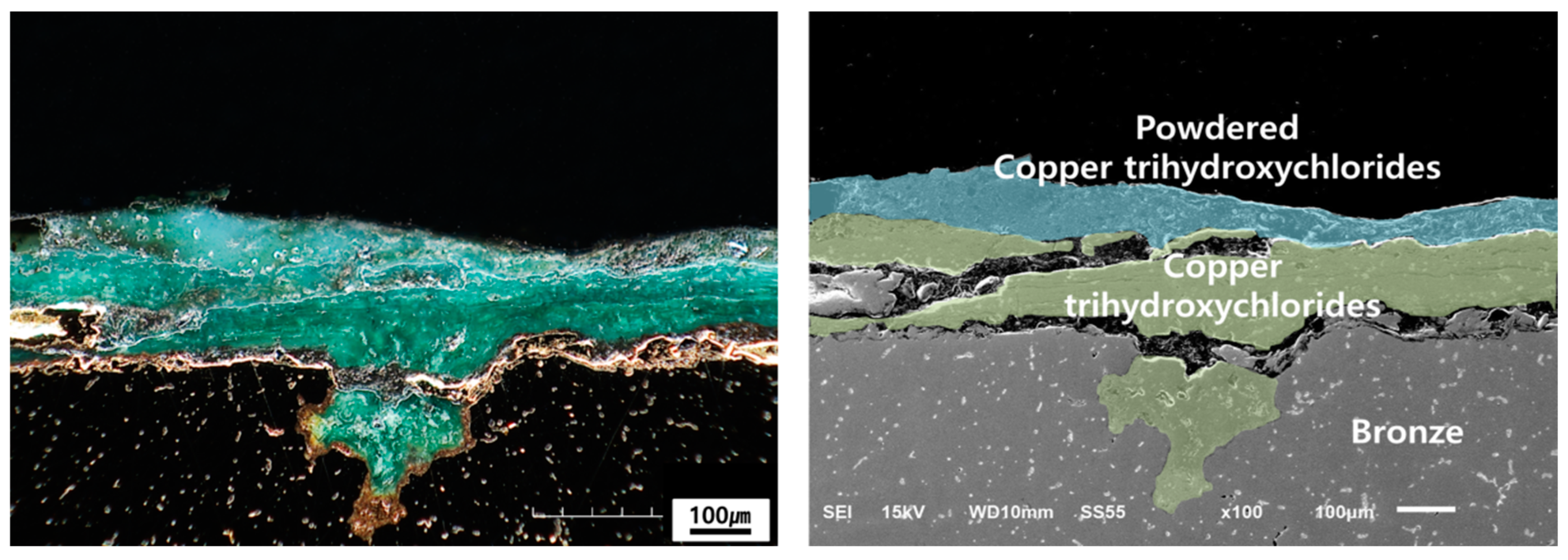

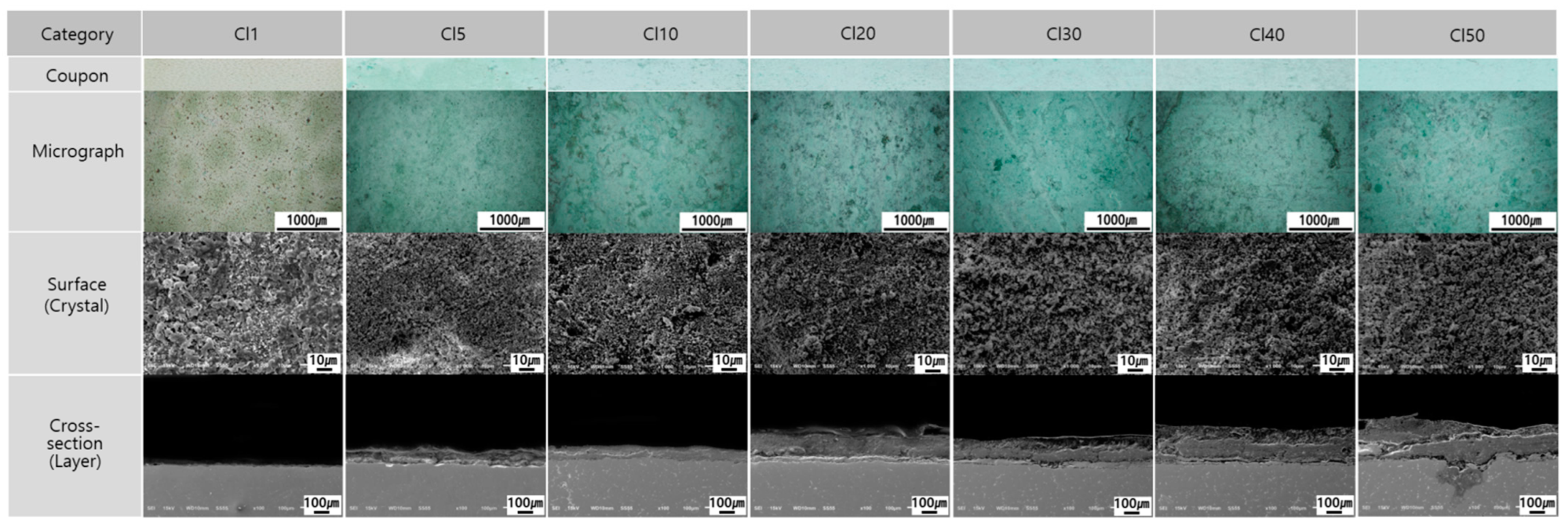
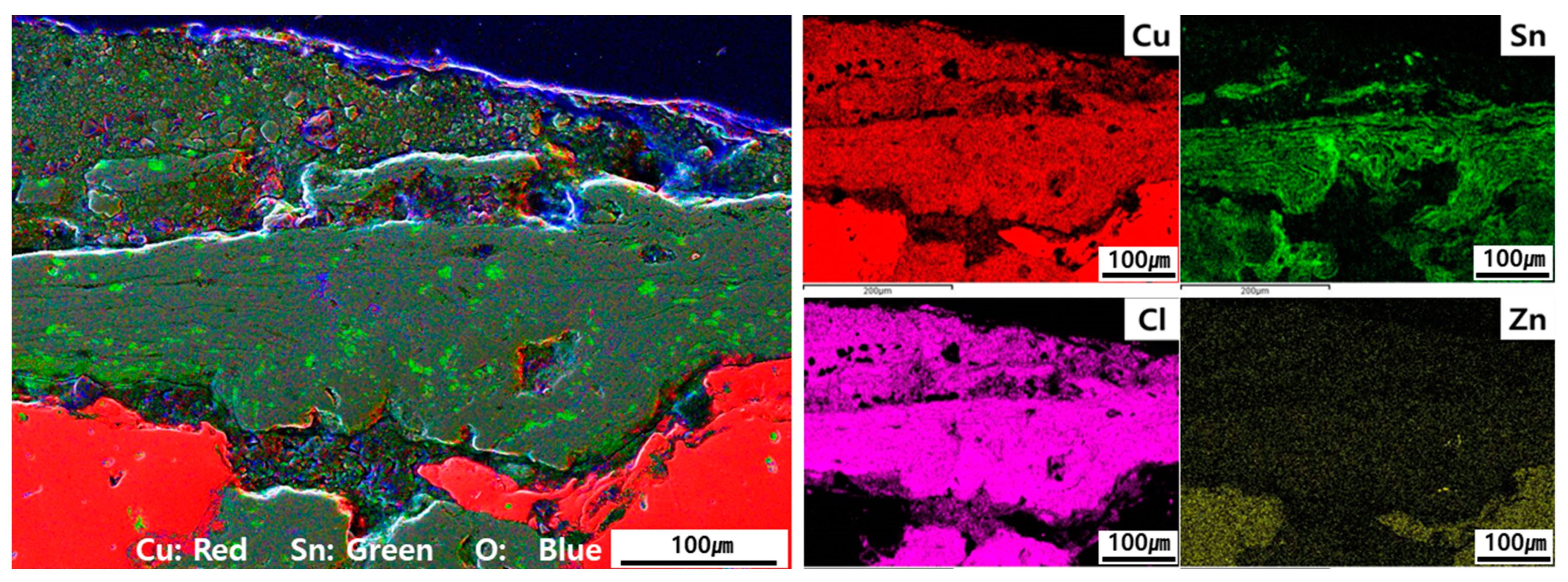
| Composition (wt%) | ||||
|---|---|---|---|---|
| Cu | Zn | Sn | Pb | Total |
| 88.8 | 5.1 | 3.1 | 3 | 100 |
| Patina | Chloride Patina |
|---|---|
| Category | |
| Corrosive solution | Aqueous solution of 0.5 M CuCl2 and 0.1 M HCl (in deionized water) |
| Specimen fabrication | 50 cycles of (24 h deposition → 24 h natural drying) |
| No. | Position | Composition (wt%) | Layer | |||||
|---|---|---|---|---|---|---|---|---|
| Cu | Zn | Sn | Pb | O | Cl | |||
| Cl1 | 1 | 85.61 | 7.93 | 3.57 | 1.38 | 1.49 | 0.02 | bronze |
| 2 | 42.85 | 0.55 | - | 9.24 | 26.63 | 20.73 | outer powder layer | |
| 3 | 41.77 | 1.76 | 0.17 | 6.57 | 29.01 | 20.72 | ||
| 4 | 38.34 | 1.34 | 0.01 | 7.00 | 33.24 | 20.06 | ||
| 5 | 29.85 | 1.52 | - | 6.03 | 47.02 | 15.58 | ||
| 6 | 42.70 | 0.71 | 0.15 | 1.71 | 30.49 | 24.23 | ||
| Cl5 | 1 | 85.51 | 8.07 | 3.47 | 1.53 | 1.34 | 0.09 | bronze |
| 2 | 40.56 | 0.08 | 1.30 | 1.03 | 51.91 | 5.12 | outer powder layer | |
| 3 | 21.52 | - | - | - | 72.76 | 5.72 | ||
| 4 | 31.05 | 0.46 | 0.06 | 2.88 | 37.2 | 28.35 | ||
| 5 | 18.70 | 0.57 | - | 0.84 | 70.92 | 8.98 | ||
| 6 | 42.17 | - | - | 4.83 | 40.63 | 12.37 | ||
| Cl20 | 1 | 85.29 | 7.95 | 4.07 | 1.55 | 1.09 | 0.04 | bronze |
| 2 | 24.57 | 0.15 | 23.59 | 6.02 | 15.81 | 29.86 | internal uniform layer | |
| 3 | 47.32 | 0.84 | 9.77 | 0.79 | 24.51 | 16.77 | ||
| 4 | 33.63 | 0.84 | 25.46 | 0.76 | 24.76 | 14.54 | ||
| 5 | 40.56 | 1.91 | 22.99 | 4.16 | 20.31 | 10.08 | ||
| 6 | 46.84 | 0.53 | 9.25 | 2.12 | 20.35 | 20.92 | ||
| 7 | 32.86 | 1.15 | 18.98 | 1.08 | 26.71 | 19.23 | ||
| 8 | 40.85 | 0.68 | 12.12 | 1.15 | 19.85 | 25.36 | ||
| 9 | 49.9 | - | 0.02 | 2.88 | 25.94 | 21.26 | outer powder layer | |
| 10 | 37.04 | - | 0.82 | 6.63 | 24.47 | 31.04 | ||
| 11 | 42.76 | - | 0.64 | 3.43 | 31.14 | 22.03 | ||
| 12 | 29.54 | - | 0.09 | 1.45 | 16.60 | 18.75 | ||
| Cl50 | 1 | 84.87 | 7.79 | 3.78 | 2.87 | 0.56 | 0.13 | bronze |
| 2 | 50.23 | - | 6.64 | 1.3 | 21.04 | 20.8 | internal uniform layer | |
| 3 | 56.72 | - | 0.32 | - | 22.82 | 20.14 | ||
| 4 | 89.58 | 8.51 | 1.43 | - | 0.39 | 0.09 | alloy molten layer | |
| 5 | 85.93 | 7.59 | 6.08 | - | 0.31 | 0.09 | ||
| 6 | 85.82 | 7.44 | 2.81 | 0.25 | 3.05 | 0.63 | ||
| 7 | 83.11 | 7.44 | 3.35 | 1.13 | 4.27 | 0.69 | ||
| 8 | 57.94 | 3.92 | 4.69 | 5.46 | 17.81 | 10.18 | boundary between microstructure and corrosion layer | |
| 9 | 52.54 | 2.03 | 1.50 | 1.64 | 20.30 | 22.00 | ||
| 10 | 53.73 | 3.65 | 2.21 | 1.25 | 24.24 | 14.91 | ||
| 11 | 57.70 | 3.17 | 4.65 | 3.11 | 17.57 | 13.80 | ||
| 12 | 42.65 | - | 17.52 | 1.89 | 21.39 | 16.55 | internal uniform layer | |
| 13 | 42.34 | 0.02 | 16.05 | 1.54 | 18.93 | 21.13 | ||
| 14 | 32.18 | 0.81 | 21.77 | 4.29 | 21.29 | 19.66 | ||
| 15 | 46.64 | - | 9.35 | 1.81 | 19.90 | 22.31 | ||
| 16 | 54.99 | - | - | 0.53 | 20.87 | 23.61 | outer powder layer | |
| 17 | 51.94 | - | 0.51 | 0.34 | 22.13 | 25.08 | ||
| 18 | 50.41 | 0.33 | 1.31 | 1.44 | 20.56 | 25.97 | ||
Disclaimer/Publisher’s Note: The statements, opinions and data contained in all publications are solely those of the individual author(s) and contributor(s) and not of MDPI and/or the editor(s). MDPI and/or the editor(s) disclaim responsibility for any injury to people or property resulting from any ideas, methods, instructions or products referred to in the content. |
© 2023 by the author. Licensee MDPI, Basel, Switzerland. This article is an open access article distributed under the terms and conditions of the Creative Commons Attribution (CC BY) license (https://creativecommons.org/licenses/by/4.0/).
Share and Cite
Kwon, H. Corrosion Behaviors of Artificial Chloride Patina for Studying Bronze Sculpture Corrosion in Marine Environments. Coatings 2023, 13, 1630. https://doi.org/10.3390/coatings13091630
Kwon H. Corrosion Behaviors of Artificial Chloride Patina for Studying Bronze Sculpture Corrosion in Marine Environments. Coatings. 2023; 13(9):1630. https://doi.org/10.3390/coatings13091630
Chicago/Turabian StyleKwon, Heehong. 2023. "Corrosion Behaviors of Artificial Chloride Patina for Studying Bronze Sculpture Corrosion in Marine Environments" Coatings 13, no. 9: 1630. https://doi.org/10.3390/coatings13091630
APA StyleKwon, H. (2023). Corrosion Behaviors of Artificial Chloride Patina for Studying Bronze Sculpture Corrosion in Marine Environments. Coatings, 13(9), 1630. https://doi.org/10.3390/coatings13091630







